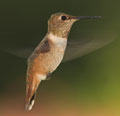As needed
 Green Hermit Phaethornis guCredit: Gualberto Becerra(Size: 9.25 kb) |
Hummingbirds must have flowering plants available to them throughout the year. In the tropics, there are blossoms all year long. Thus, most species travel only short distances. Few hummingbird species travel far enough to describe it as a true migration. Generally, hummingbirds are much more mobile than Hermits.
Living in the North
 Calliope Hummingbird Stellula calliopeCredit: Steve Geer(Size: 18.39 kb) |
Most migratory hummingbirds are in reality partial migrants; in other words, only part of the population undertakes significant journeys: the individual birds that frequent the most northerly part of the nesting area. Among the species in North America where the entire population leaves the nesting area are the Ruby-throated Hummingbird (Archilocus colubris), the Black-chinned Hummingbird (Archilocus alexandri), the Rufous Hummingbird (Selasphorus rufus) and the Calliope Hummingbird (Stellula calliope). The latter species is known as the tiniest long-distance migratory bird in the world.
Two routes
 Ruby-throated Hummingbird Archilochus colubrisCredit: Serge Beaudette(Size: 233.17 kb) |
The migratory route of the Ruby-throated Hummingbird is a long one. Although most of the species follow the US-Mexican coast, many others cross the Gulf of Mexico, a route with no landing for 800 to 1000 km. They apparently travel in groups of various sizes, flying over the water at low altitude. They have been observed flying over the Gulf of Mexico just 8 metres above the surface and between the waves on Lake Erie on a windy day. The males are the first to arrive in the spring and fall, followed by the females, then the immature birds, each about a week apart.
In a loop
 Rufous Hummingbird Selasphorus rufusCredit: Frank Leung(Size: 29.91 kb) |
Some northern nesters follow a loop-shaped migratory route, changing itineraries in the fall and spring. This is the case for the Rufous Hummingbird (Selasphorus rufus), which flies along the Coast Range to the south, Sierra Nevada in the west, and the Rocky Mountains more to the east. In January, they return in the opposite direction following the Pacific coast, arriving in northwestern North America in April.
To learn more about Canadian species, follow this link. |

